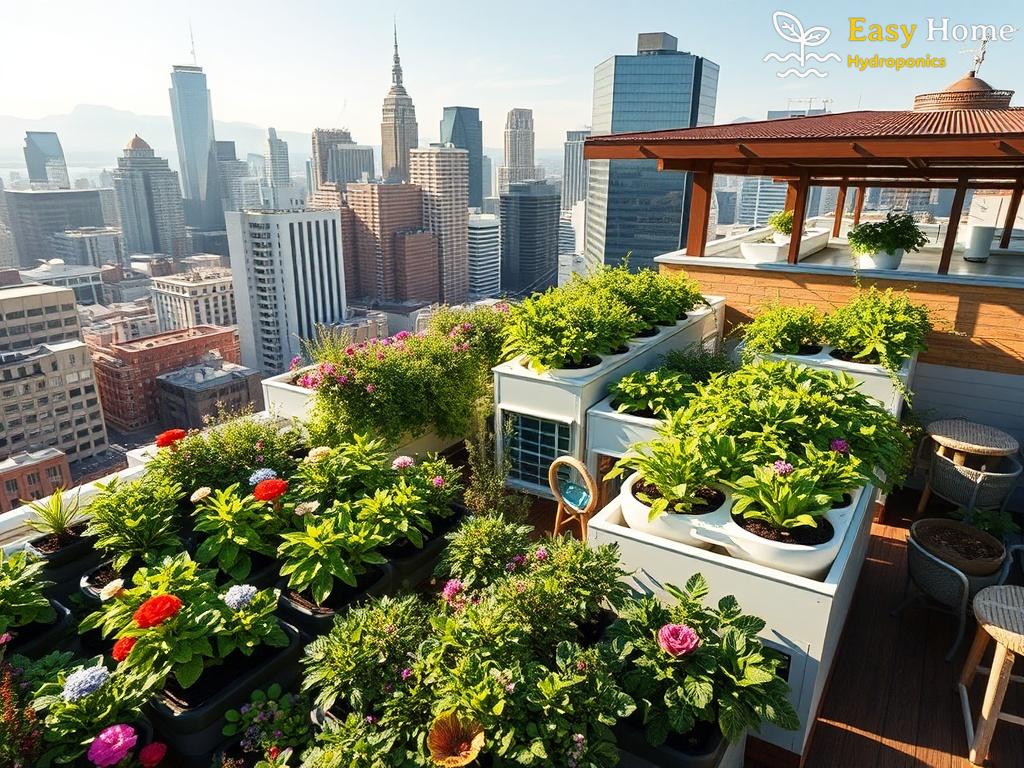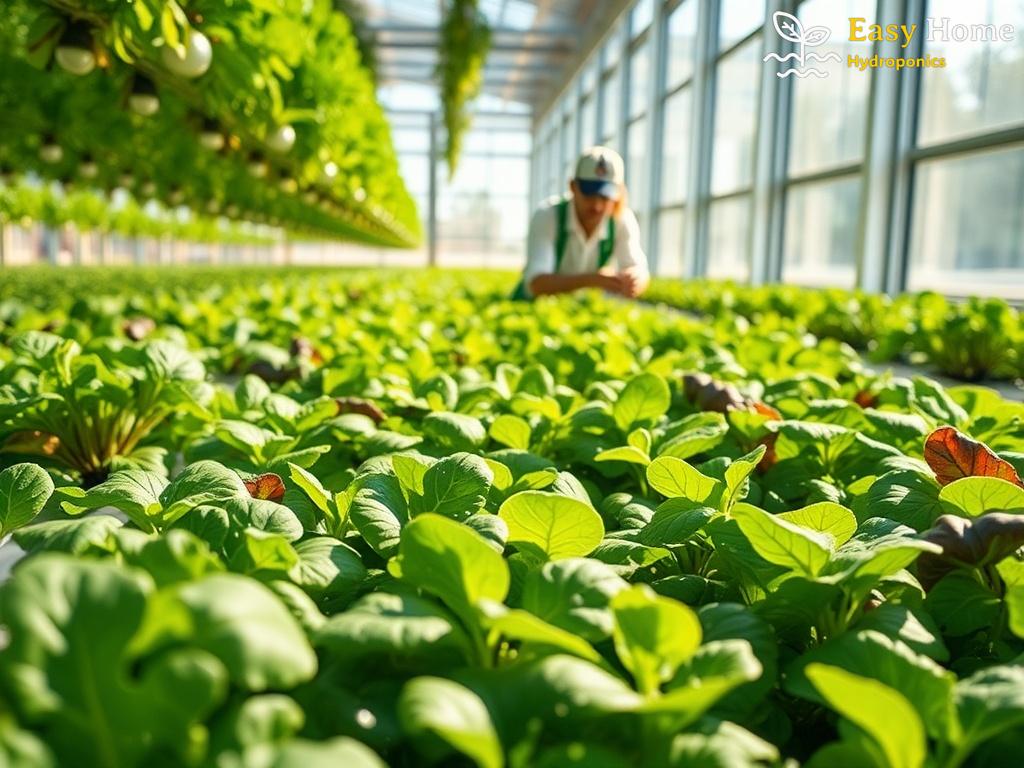Urban Oasis: Transforming Rooftops into Green Havens

As cities grow taller and more densely populated, the quest for green spaces becomes increasingly vital. Urban rooftops, often overlooked and underutilized, present a unique opportunity to combat this challenge. With the rise of hydroponic gardening, these once barren rooftops are evolving into lush, productive gardens, transforming our urban landscapes into vibrant oases.
Hydroponics: The Science Behind Urban Gardening
Hydroponics, the method of growing plants without soil, is revolutionizing how we think about gardening in urban environments. This innovative technique allows for efficient use of space, water, and nutrients, making it an ideal solution for rooftops where traditional gardening methods would struggle. Cities are beginning to embrace this technology, and the results are nothing short of spectacular.
The Benefits of Rooftop Hydroponics
Creating a green haven on rooftops not only enhances aesthetic appeal but also offers a plethora of environmental benefits. Rooftop gardens can help reduce urban heat islands, improve air quality, and even mitigate stormwater runoff. Furthermore, they provide fresh produce right at the residents’ doorstep, promoting healthier lifestyles and reducing the carbon footprint associated with transporting food.
Here are some key advantages of hydroponic gardening on rooftops:
- Space Efficiency: Hydroponics maximizes vertical space, making it possible to grow more food in smaller areas.
- Water Conservation: This method uses 90% less water than traditional soil gardening.
- Year-Round Growth: Controlled environments allow for year-round cultivation, regardless of external weather conditions.
- Reduced Pesticide Use: Hydroponics typically requires fewer pesticides, leading to healthier plants and produce.
- Community Engagement: Rooftop gardens can foster community spirit, bringing neighbors together for gardening initiatives.
Case Studies: Cities Leading the Charge
Several cities around the world have successfully implemented rooftop hydroponic gardens, setting examples for others to follow. These initiatives not only demonstrate the feasibility of urban gardening but also inspire communities to take action.
| City | Project Name | Description |
|---|---|---|
| New York City | Brooklyn Grange | A leading rooftop farm that produces over 50,000 pounds of organic produce annually. |
| Toronto | Evergreen Brick Works | Transforms an old brick factory into an urban agriculture hub, promoting green practices. |
| Singapore | Sky Greens | The world’s first vertical farm that utilizes hydroponic technology to grow vegetables in a sustainable manner. |
As these urban oases continue to flourish, the potential for rooftop hydroponic gardens is limitless. The combination of innovative technology and community engagement can redefine our cities, making them not just places to live but thriving ecosystems.
Soil-less Success: The Science Behind Hydroponics
As urban environments continue to expand, the innovative practice of hydroponics emerges as a beacon of hope for sustainable urban living. This soil-less gardening technique, which utilizes nutrient-rich water solutions to grow plants, is not just a fascinating scientific advancement; it represents a paradigm shift in how we approach food production in densely populated areas. By understanding the science behind hydroponics, we can appreciate its transformative potential in our cities.
The Mechanisms of Hydroponic Growth
At its core, hydroponics operates on a few key principles that differentiate it from traditional gardening. Instead of relying on soil, plants obtain nutrients directly from a nutrient solution, allowing for faster growth rates and higher yields. The process involves a systematic approach to nutrient delivery, light exposure, and environmental control. With the use of LED grow lights, plants can receive the optimal light spectrum necessary for photosynthesis, regardless of the season or time of day. Furthermore, hydroponic systems can be tailored to specific plant needs, enhancing their growth potential.
Types of Hydroponic Systems and Their Efficiency
Hydroponic systems come in various forms, each with unique benefits. The most common include the Nutrient Film Technique (NFT), Deep Water Culture (DWC), and Aeroponics. In NFT systems, a thin film of nutrient solution continuously flows over the roots, providing them with the necessary hydration and nutrients. DWC systems submerge roots in a nutrient solution, allowing for maximum oxygen absorption. Aeroponics takes it a step further by misting the roots with nutrient-rich water, ensuring they receive adequate moisture while promoting aeration.
These systems not only enhance growth but also contribute to significant resource savings. For instance, hydroponics can utilize up to 90% less water compared to traditional farming, a crucial advantage in urban settings facing water scarcity. As cities grapple with the consequences of climate change and urbanization, the efficiency of hydroponics becomes increasingly vital.
| Hydroponic System | Advantages | Best For |
|---|---|---|
| Nutrient Film Technique | Efficient nutrient delivery, low water usage | Leafy greens, herbs |
| Deep Water Culture | Simple setup, high oxygen availability | Fast-growing plants like lettuce |
| Aeroponics | Maximum oxygen exposure, minimal water use | High-value crops, flowers |
As urban centers continue to embrace hydroponic gardening, the fusion of science and sustainability paves the way for greener, more resilient cities. With each rooftop garden that flourishes, the vision of a vibrant urban ecosystem becomes a reality, showcasing the incredible potential of soil-less agriculture.
Sustainable Solutions: Hydroponics in the Fight Against Food Deserts
In the heart of bustling cities, while skyscrapers rise and urban sprawl expands, an alarming reality unfolds: food deserts, areas where access to affordable and nutritious food is limited. This growing concern has sparked a revolution in urban agriculture, with hydroponic gardening emerging as a beacon of hope. By transforming neglected rooftop spaces into thriving gardens, cities are not only combating food deserts but also redefining the way we think about food production and accessibility.
Hydroponics: A Game-Changer for Food Security
Hydroponic systems present a remarkable solution to the challenge of food deserts. By utilizing nutrient-rich water to grow plants without soil, hydroponics enables food production where traditional agriculture would falter. Imagine a rooftop in a food desert, where residents can harvest fresh vegetables and herbs just steps away from their homes. This innovative approach not only addresses the immediate need for fresh produce but also fosters a sense of community and self-sufficiency.
Moreover, hydroponics allows for year-round cultivation, ensuring that communities have consistent access to fresh food, regardless of seasonal limitations. As urban populations continue to grow, the capacity to produce food locally becomes increasingly vital. Hydroponics offers an efficient, sustainable solution, utilizing vertical space to maximize yield without the need for expansive land.
Empowering Communities Through Education and Engagement
Hydroponic gardening is not just about growing food; it’s about growing knowledge and community resilience. Many urban rooftop gardens incorporate educational programs that teach residents how to cultivate their own food. Through workshops and hands-on experiences, individuals learn about sustainable practices and the importance of nutrition. This empowerment can lead to healthier lifestyles and a deeper connection to the food they consume.
Furthermore, these gardens often serve as gathering spaces where neighbors can come together, share resources, and foster relationships. They become micro-ecosystems of support, where the act of gardening transcends mere food production, cultivating a stronger, more interconnected community.
A Vision for the Future
As cities continue to innovate in the face of food insecurity, the rise of hydroponic gardening on urban rooftops presents a promising pathway to sustainability. By focusing on local food production, we can alleviate the burdens of food deserts while simultaneously addressing environmental concerns like urban heat and air quality. The potential for rooftop hydroponics is boundless, and as more cities embrace this transformative practice, we inch closer to a future where every community has access to fresh, healthy food.
Cultivating Community: Rooftop Gardens as Social Hubs
In the midst of concrete jungles and bustling streets, rooftop gardens have emerged not only as green retreats but also as vibrant social hubs that cultivate community spirit. These elevated gardens serve as gathering places where residents can connect, share knowledge, and foster relationships, all while nurturing a shared love for plants and sustainable living. The beauty of rooftop gardening lies in its ability to transform isolated urban spaces into thriving micro-communities, bridging the gap between nature and city life.
Shared Spaces for Collective Growth
Rooftop gardens are more than just patches of greenery above our heads; they are communal spaces that invite collaboration and creativity. These gardens often host workshops, potlucks, and gardening clubs, allowing individuals from diverse backgrounds to come together. The act of growing food collectively fosters a sense of belonging and purpose, transforming neighbors into friends and strangers into allies.
As participants learn about hydroponic techniques and sustainable gardening practices, they not only gain valuable skills but also develop a deeper connection with their food and environment. This shared experience contributes to a culture of sustainability, where individuals become advocates for greener practices within their communities.
Building Resilience Through Community Engagement
Rooftop gardens act as catalysts for social change, addressing issues of food insecurity while simultaneously strengthening community ties. In neighborhoods plagued by food deserts, these gardens provide fresh produce and educational opportunities that empower residents to take charge of their nutritional needs. The gardens become platforms for advocacy, where participants can voice their concerns and collaborate on solutions to local challenges.
Moreover, the involvement in rooftop gardening projects can lead to improved mental well-being and reduced stress levels. The therapeutic effects of gardening, combined with the support of a like-minded community, create a nurturing environment that enhances the quality of life for urban dwellers. The social interactions that stem from these gardens contribute to a sense of safety, belonging, and shared responsibility.
Rooftop Gardens: A Comparative Overview
Below is a comparison showcasing the unique benefits and features of rooftop gardens as social hubs:
| Features | Community Engagement | Environmental Impact | Health Benefits |
|---|---|---|---|
| Workshops and Events | Fosters collaboration and learning | Promotes biodiversity and reduces urban heat | Encourages physical activity and reduces stress |
| Shared Harvests | Strengthens neighborly bonds | Reduces carbon footprint through local food production | Provides access to fresh, nutritious food |
| Educational Opportunities | Empowers individuals with gardening skills | Contributes to sustainable practices | Enhances mental well-being |
As cities continue to embrace the rise of hydroponic gardening, the role of rooftop gardens as social hubs will only grow in significance. These green spaces are proving to be essential not just for environmental sustainability, but also for cultivating a sense of community that enriches urban life. The future of our cities may very well depend on how well we nurture these connections, one rooftop garden at a time.
Tech Meets Nature: Innovations Driving Hydroponic Gardening
Revolutionary Technologies Transforming Urban Agriculture
As we witness the convergence of technology and nature, hydroponic gardening is leading the charge in urban agriculture, particularly in rooftop spaces. This innovative approach is not merely about growing plants without soil; it’s about harnessing cutting-edge technologies that create efficient systems for food production. With the integration of smart sensors, automated nutrient delivery, and climate control systems, urban gardeners can optimize their plants’ growth conditions in ways that were previously unimaginable. These advancements are setting a new standard for how we envision urban farming, making it more productive and sustainable than ever before.
From Data to Decisions: The Role of Smart Agriculture
At the heart of this agricultural revolution is the powerful use of data analytics. Smart hydroponic systems are equipped with sensors that monitor various parameters such as pH levels, humidity, and nutrient concentration in real-time. This wealth of information enables gardeners to make informed decisions that can significantly enhance yield and resource efficiency. For instance, by adjusting nutrient mixtures based on sensor feedback, growers can tailor their approach to the specific needs of their plants, ensuring optimal growth. Moreover, this data-driven methodology minimizes waste, making urban farming not only feasible but also environmentally responsible.
Eco-Friendly Innovations Leading the Green Movement
As cities grapple with environmental challenges, hydroponic gardening presents a sustainable solution that is gaining traction among eco-conscious urban dwellers. Innovations like vertical farming systems and modular garden kits are making it easier than ever for individuals and communities to engage in hydroponics. These technologies allow for the cultivation of fresh produce in compact spaces without compromising on quality. Furthermore, utilizing renewable energy sources, such as solar panels, to power these systems enhances their sustainability profile. This synergy of technology and nature not only promotes food security but also encourages a greener lifestyle, resonating with the growing demand for eco-friendly practices in our daily lives.




